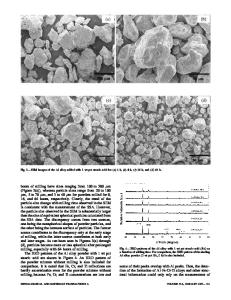Thermoelectric Performance of Nanostructured ZrNiSn Compounds Synthesized by Mechanical Alloying
- PDF / 187,033 Bytes
- 6 Pages / 612 x 792 pts (letter) Page_size
- 73 Downloads / 294 Views
1267-DD03-12
Thermoelectric Performance of Nanostructured ZrNiSn Compounds Synthesized by Mechanical Alloying Jeffrey D. Germond1,3, Paul J. Schilling1,3*, Nathan J. Takas2,3, Pierre F. P. Poudeu2,3 1
Department of Mechanical Engineering, University of New Orleans, New Orleans, LA, 70148, U.S.A. 2 Department of Chemistry, University of New Orleans, New Orleans, LA 70148, U.S.A. 3 Advanced Materials Research Institute, University of New Orleans, New Orleans, LA 70148, U.S.A. ABSTRACT Samples with a composition ZrNiSn were synthesized by a combination of mechanical alloying (MA) and consolidation by either Spark Plasma Sintering (SPS) or hot pressing (HP). Appropriate stoichiometric ratios of the starting materials were milled under an inert atmosphere in a high energy ball mill for 6 hours, achieving a half-Heusler phase. X-Ray diffraction patterns of as milled powders and consolidated samples were compared and analyzed for phase purity. Thermal conductivity, electrical conductivity and Seebeck coefficient were measured as a function of temperature in the range 300 K to 800 K and compared with measurements reported for high temperature solid state reaction synthesis of this compound. HP samples, compared to SPS samples, demonstrate increased grain growth due to longer heating times. Reduced grain size achieved by MA and SPS causes increased phonon scattering due to the increased number of grain boundaries, which lowers the thermal conductivity without doping the base system with addition phonon scattering centers. INTRODUCTION Thermoelectric materials have the promising ability to convert heat directly into electricity. They have continued to gain interest due to the multitude of composition and fabrication methods that, when altered, yield improvements in performance. Semiconductors in particular, can be tuned by doping, grain refinement and consolidation techniques, all of which have the potential to improve the transport properties and the figure of merit (ZT) [1-5]. ZT is defined as
ZT = S 2σT / κ
(1)
where S, σ , κ and T are Seebeck coefficient, electrical conductivity, thermal conductivity and absolute temperature, respectively. ZrNiSn half-Heusler compounds have been shown to yield a ZT = 0.2 at a temperature of 900 K under optimal synthesis methods, but still have room for improvement by reducing the thermal conductivity [11]. Previous studies have shown that doping the ZrNiSn lattice with alternate elements increase the number mass phonon scattering
centers and consequently reduces lattice thermal conductivity [2,7]. These doped samples achieve a ZT = 1.0 under optimal synthesis methods [6]. The aim of this study is to show a reduction in thermal conductivity and increase in ZT on the base system of ZrNiSn without any dopants. EXPERIMENTAL Elemental powders of Zr, Ni and Sn were combined (stoichiometric ratio of 1:1:1) in an argon atmosphere, sealed within a hardened steel vial, and mechanically alloyed in a SPEX shaker mill to form a half-Heusler phase. Initial powder mass of 6 grams and 6 hardened s
Data Loading...











